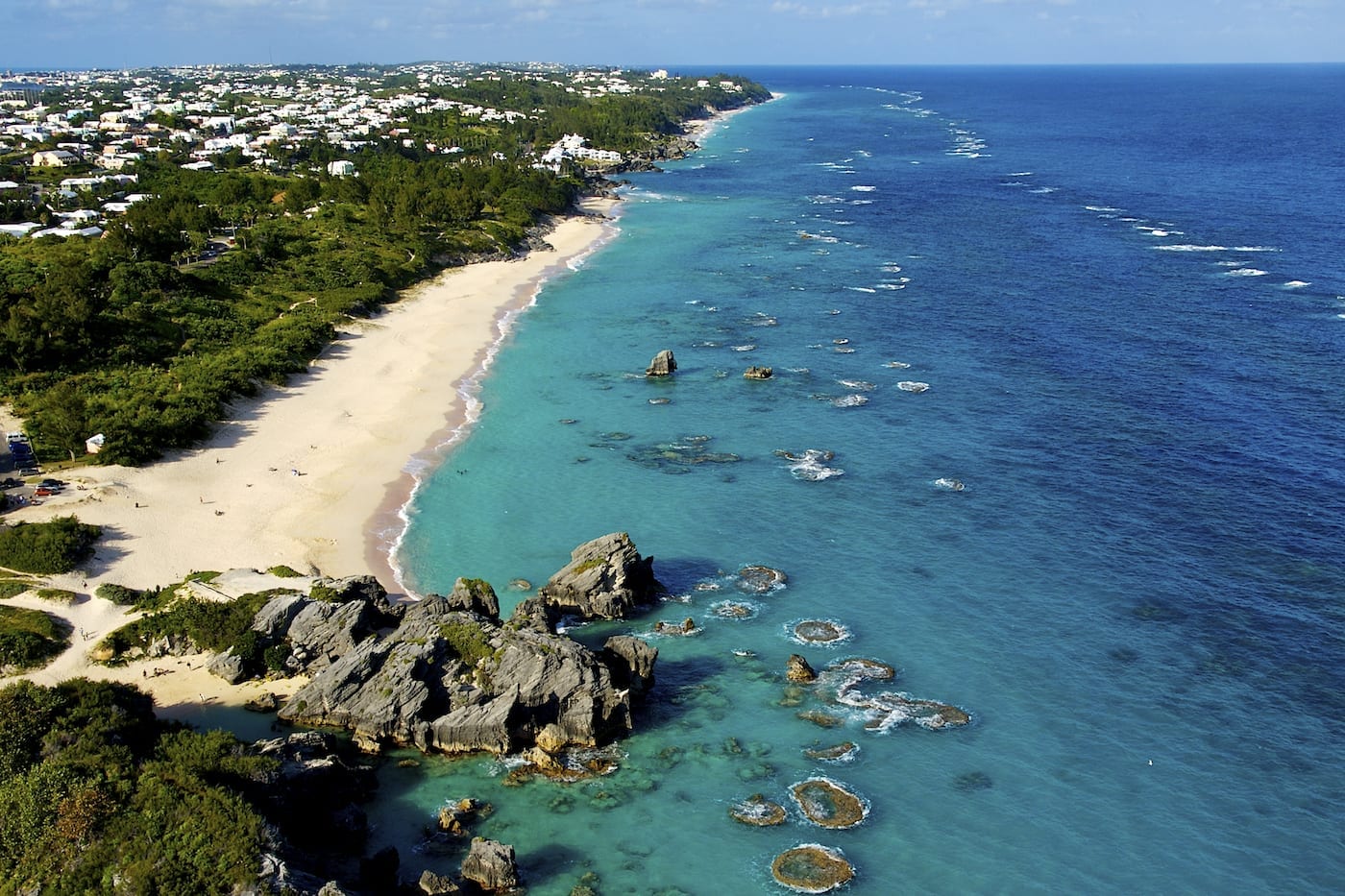Island’s beauty & unhurried ways refreshed many a wearing soul.
By Abby Deering
Only 700 miles off the coast of South Carolina, Bermuda is not, as it’s often mistaken, in the Caribbean. It is a place unto itself — a northerly subtropical curiosity in the Atlantic’s Sargasso Sea.
A playground for Boston Brahmins in the late 19th century, today Bermuda is considered the more attractive, hassle-free alternative to the Hamptons or Nantucket. Less than a 2-hour flight from most major airports on the East Coast, those looking for a quick weekend getaway are trading traffic jams on the Jitney for direct flights on Jet Blue.
A five-year recession took the wind out of the country’s sails from 2009 to 2014, but a winning bid to host the biggest event in the sport of sailing in 2017 provided a much-needed economic boost to the tune of $250 million, revitalizing the tourism industry. The Louis Vuitton America’s Cup showcased Bermuda as one of the best sailing destinations in the world and reminded the world of its natural beauty, maritime heritage and the warm, welcoming nature of its residents.
Bermuda has a rich history of straddling the Old World and New with an unusual degree of panache and ease. A unharried way of life prevails, and any sort of freneticism is conspicuously absent.
The oldest remaining British Overseas Territory, Bermuda was settled in 1609 when the Sea Venture wrecked on its shores. To this day, a sense of English civility remains, reminiscent of a genteel Old-World manner found in the Carolinas, Bermuda’s latitudinal neighbors to the west. (The connection here is not merely geographical; Charleston, South Carolina, was founded by Bermudians in 1670, and many of its historic buildings are constructed from Bermuda stone.)
Pink-blossomed oleander bushes line the narrow, winding island roads, and the surrounding aquamarine seas provide a stunning backdrop to some of the New World’s oldest settlements, including spectacular stone forts and the town of St. George, with its cobblestone streets.
Custom, happenstance, and history have converged to create a landscape that is uniquely picturesque and delightfully original. A ban on outdoor advertising means no billboards or neon signs sully the scenery. There are no restaurant franchises— no McDonald’s, no Subways, no Pizza Huts. All restaurants must be Bermudian-owned, so you’ll find none of the ubiquitous corporate food chains, except for a single Kentucky Fried Chicken, owned by a Bermudian.
Bright white, terraced roofs perch atop limestone cottages painted in pastel colors of every hue. The shape of these roofs greatly aids the collection of rainwater, which the country relies on. The island has no other natural source of fresh water.
Bermuda has a rich history
of straddling the Old World &
New with an unusual degree
of panache and ease.
![]()
Bermuda is made up of 138 islands formed in the shape of a fishhook and stretching some 22 miles, with bridges and causeways connecting the eight largest islands. Cars were not allowed on the island until 1946, and to this day, the size of cars is restricted due to the diminutive roadways. This island has an excellent system of public buses and ferries, but the best way to discover Bermuda (especially for tourists who are not allowed to rent cars) is by scooter.
When not zipping about the island on scooters, visitors can use the abounding nature trails to explore.
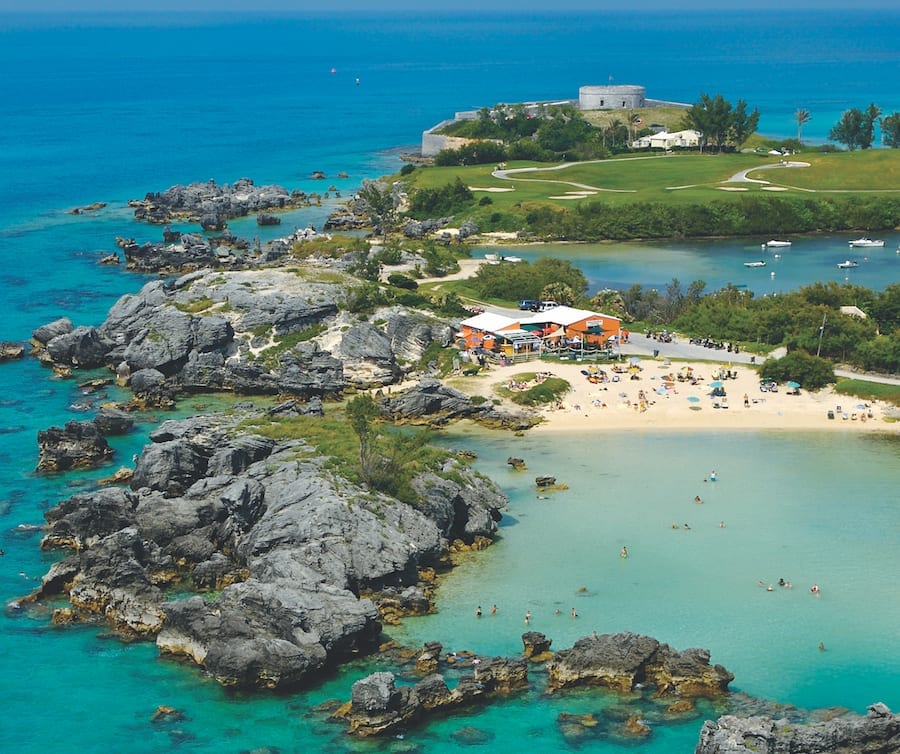
A view of Tobacco Bay and beyond to Fort St. Catherine, on the northern tip of the island.
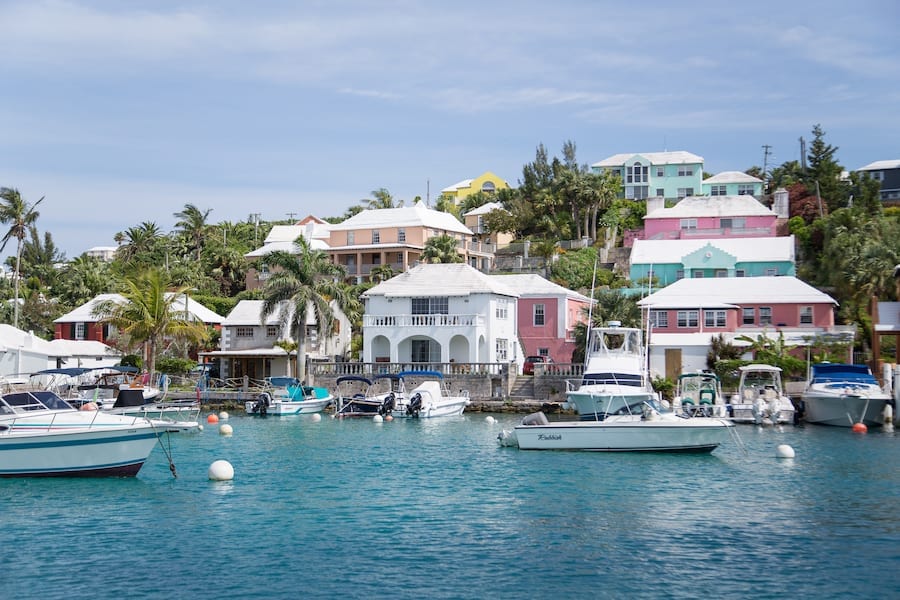
The island’s hallmark pastel-hued homes perched above the water in Flatts village.
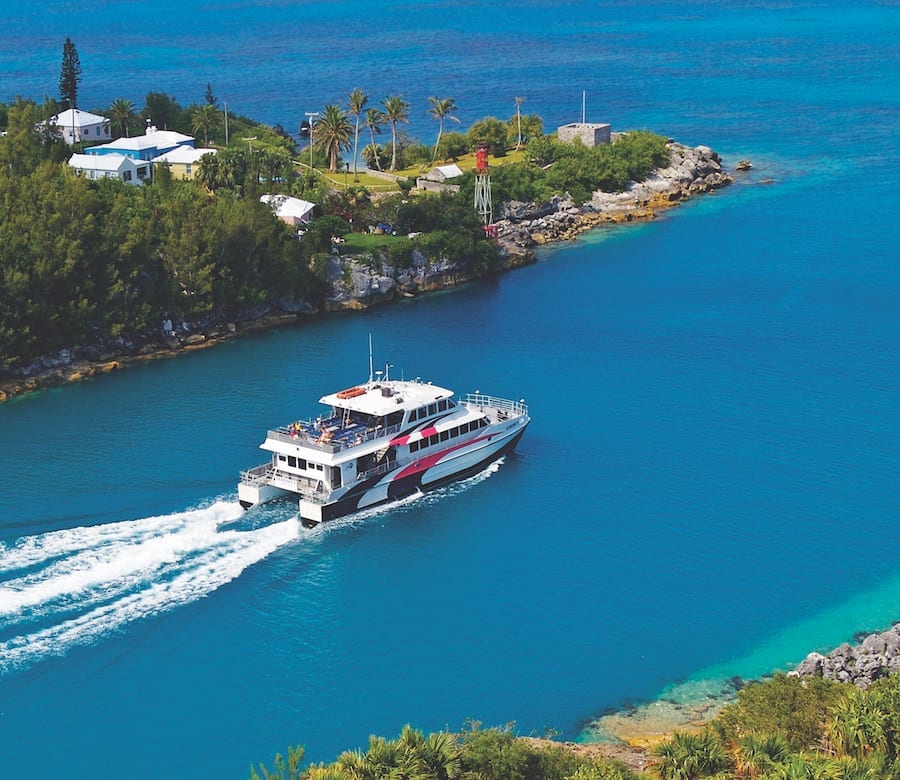
Ferry rides give the opportunity to see Bermuda’s beauty from a different vantage point.
Along the south shore, miles of nature trails scatter across the coastline, traversing stunning sea cliffs, secret coves, and Bermuda’s trademark pink sand beaches. The shells of tiny red marine organisms growing under the coral reefs fall to the ocean floor and wash ashore, mixing with sand to create the famous salmon-colored hue.
Warmed by its proximity to the Gulf Stream, this subtropical oasis is home to the northernmost coral reef system, covering an astonishing 200 square miles. These notorious reefs have caused over 300 shipwrecks, now rich sights for underwater discovery.
For those willing to brave the metaphysical and existential depths, head over to the ledge where the coral reef sharply drops off into the Atlantic Ocean, and on a clear day, see 100 feet down.
Off the South Shore Road, a blink-and-you’ll-miss-it dirt road leads to the abandoned Southlands Estate. Winding paths reveal rambling gardens and crumbling buildings, but most impressive is the enormous Banyan tree grove with its cathedral-like arch of aerial roots that hang down and take root wherever they touch ground. Incredibly, this intricate mass of branches is made up of just three trees.
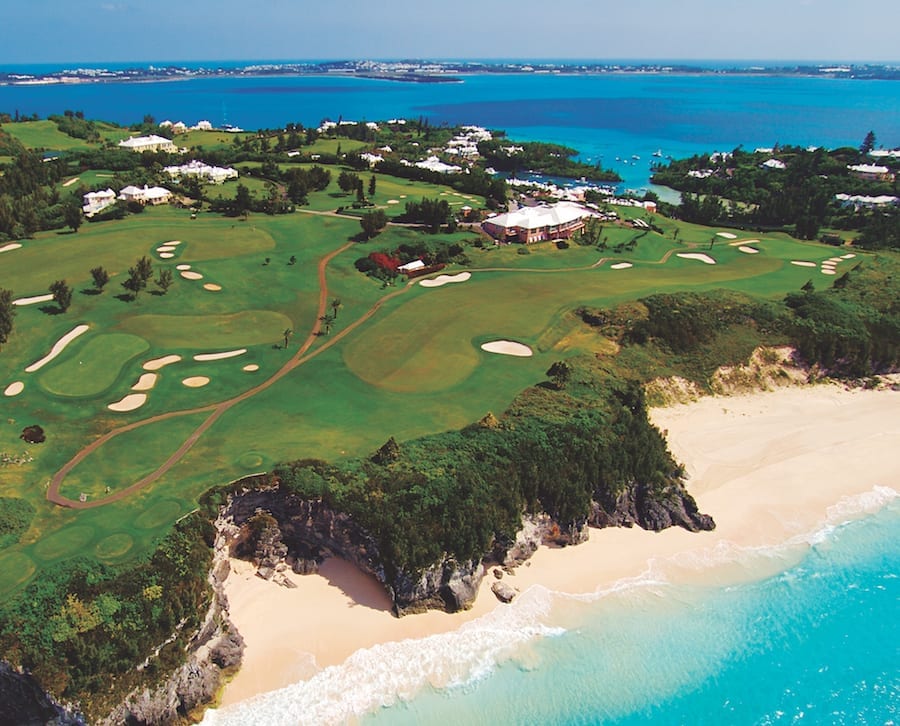
Mid Ocean Club, the No. 1 golf course in Bermuda, is ranked as one of the best in the world.
One of the several pools to enjoy on the Bermuda Rosewood property, overlooking Castle Harbor. (Photo courtesy: Rosewood Bermuda)
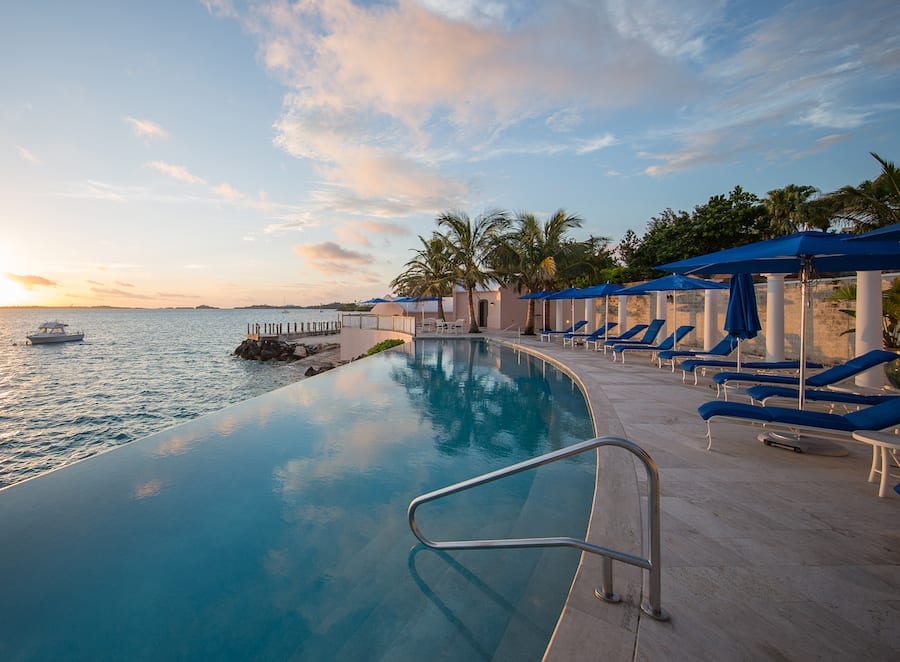
One of the several pools to enjoy on the Bermuda Rosewood property, overlooking Castle Harbor. (Photo courtesy: Rosewood Bermuda)
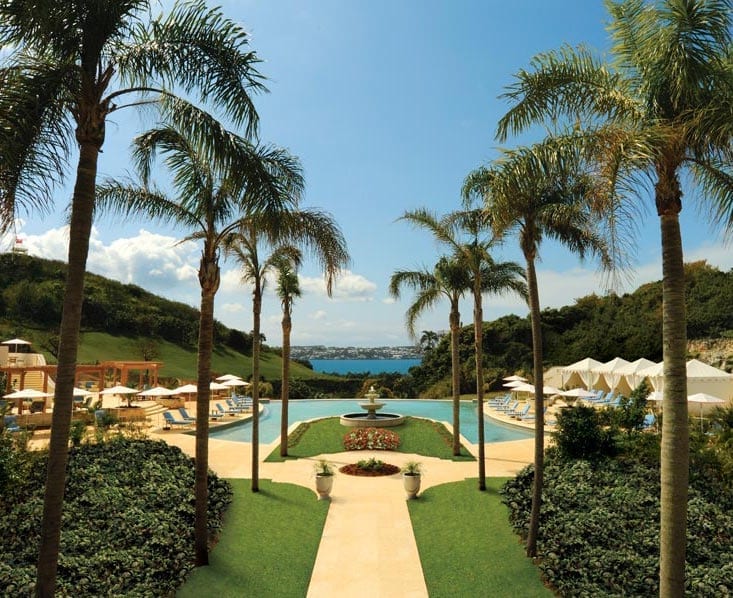
The croquet lawn and infinity pool at Rosewood Tucker’s Point Resort and Spa. (Photo courtesy: Rosewood Bermuda)
For those looking for activities of the well-manicured variety, Bermuda boasts the most golf courses per square mile in the world; Hamilton, the island’s capital, has historic buildings, a busy harbor, high-end shopping, and cosmopolitan cuisine; and just a short drive from Hamilton is Bermuda’s beautiful 36-acre Botanical Gardens and Masterworks Museum.
World famous for its rum, Bermuda has not one, but two national drinks: the Dark n’ Stormy and the Rum Swizzle. Where better to enjoy these than the Swizzle Inn, once the preferred watering hole of the late Ted Kennedy and known for its infamous tagline “Swizzle Inn, Swagger Out.”
Bermuda is also known for its ginger beer, and when it comes to finding the perfect accompanying local bite, a visit to Art Mel’s Spicy Dicy (with two hole-in-the-wall locations on the island) is a must. Its famous fish sandwich is a towering masterpiece of fresh snapper flash-fried in soybean oil, topped with coleslaw and hot sauce, precariously contained betwixt two slabs of freshly baked and toasted raisin bread.
Marcus Samuelson’s new restaurant in the Fairmont Hamilton Princess, the “Grande Dame” of Bermudian hotels, features the chef’s globally influenced signature cuisine that references the island’s fresh ingredients and classic dishes. The floor-to-ceiling glass-fronted restaurant looks out over Hamilton Harbor and features original art by Andy Warhol and Nelson Mandela.
Resorts with spas, world-class golf courses, tennis courts, multiple swimming pools, private beaches, and adjoining beach clubs dot the island, but Rosewood Tucker’s Point Hotel and Spa is, by far, the most exquisite. In an area known as “Billionaire’s Row” (both Berlusconi and Bloomberg have homes there), Tucker’s Point is the gold standard in sophistication and exclusivity. For those wishing for a more boutique experience, the new luxury hotels, Loren and The Newstead, deserve mention too. But no matter where you stay, you’re bound to experience paradise.
In the later years of his life, Mark Twain, a regular visitor to the island and a true Bermudophile, wrote to a dear friend, “You can go to heaven if you want, I’d rather stay in Bermuda.”

